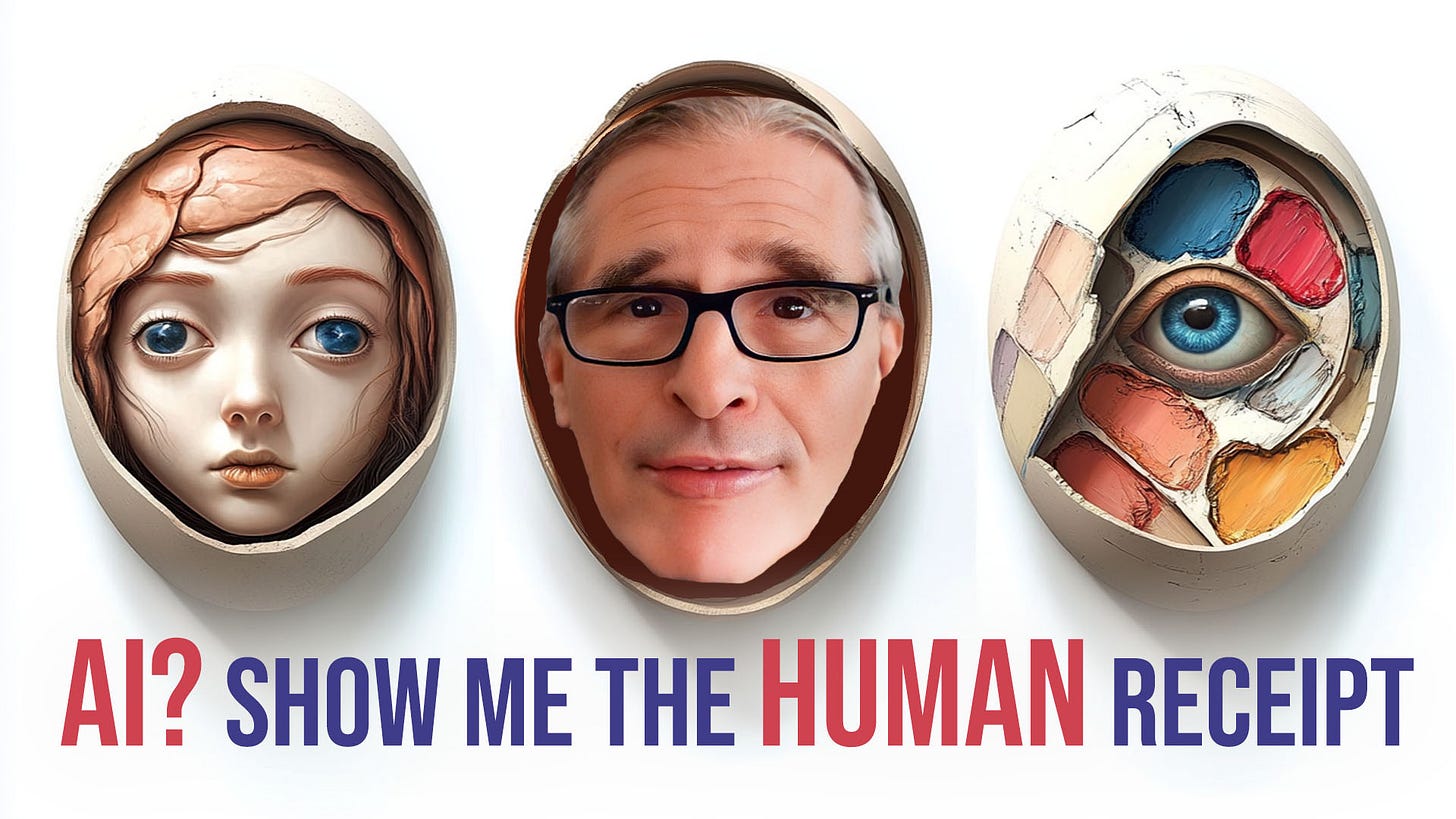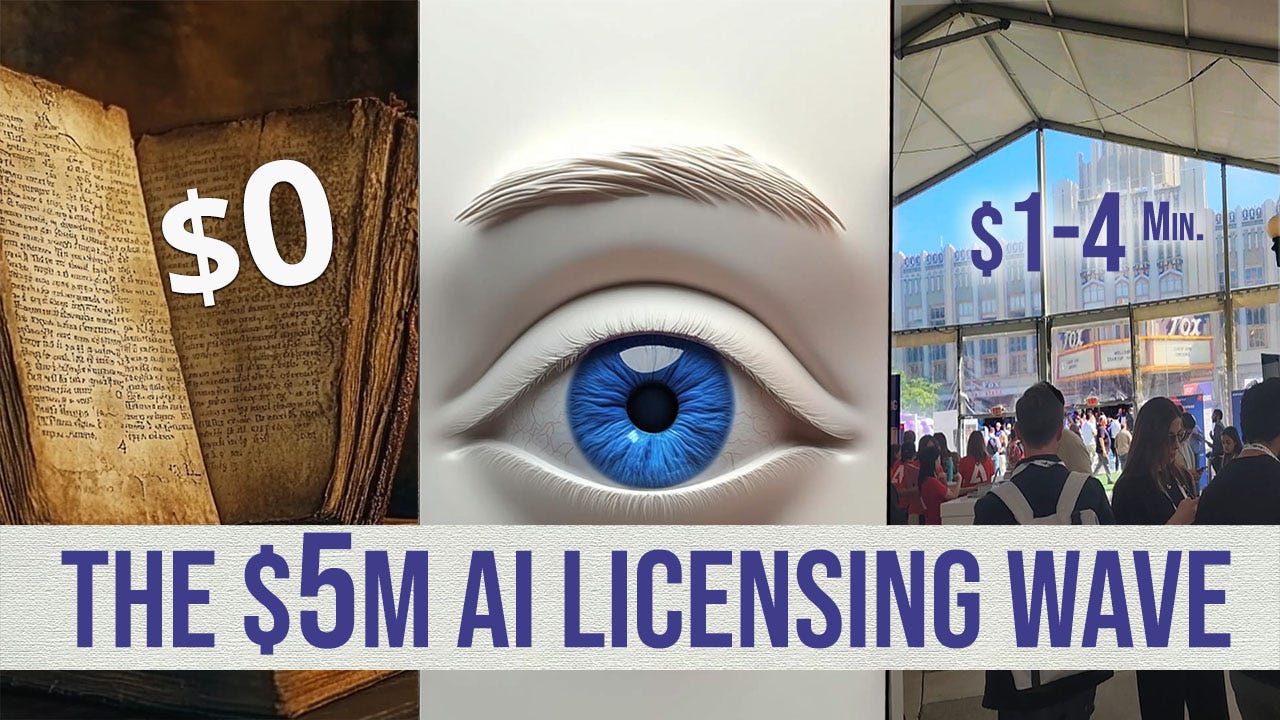The growing demand for high-quality AI training data is creating a new revenue stream for videographers and content creators.
While legal battles dominate headlines, direct licensing deals between creators and AI companies are quietly forming.
AI Video Licensing Market:
Content Creators Supply Meets AI Dev Demand
Last week, I was helping Omadeus pitch at StartupGrind near Silicon Valley. I could tell you about it—the conversations, the connections, the insights—but that's just 2D data.
This video is 4k, but the shoot isn’t great. Maybe $1 a minute?
Now imagine watching video footage of that event: people milling about, companies exhibiting their innovations, the vibrant colors, the beautiful Fox Theatre in Redwood City where keynotes were held.
That one-minute clip in 4K resolution? It might be worth $1-4 to an AI company.
Why? Because video is among the richest data sources for AI training. Instead of legal battles over scraped content, we're witnessing a licensing marketplace emerge, where AI companies pay directly for the high-quality, video data they need.
The Market Need for AI Video Licensing
The AI video licensing market is growing as AI capabilities expand. Advanced AI models, especially those focused on video generation, require massive amounts of high-quality, diverse data for training.
This growth creates immediate challenges for AI developers:
Data Quality Requirements: As models become more sophisticated, they need increasingly higher-quality training data to produce realistic results.
Legal Risks of Scraping: Major AI developers are moving away from scraping due to mounting legal challenges and copyright concerns. Companies like Google, OpenAI, and others face litigation risks when using content without proper permissions.
Diversity Needs: AI models require exposure to a wide variety of scenarios, environments, and actions to learn effectively and avoid bias—diversity that's difficult to get through public datasets alone.
These factors have created an opportunity for content creators to monetize their assets, especially unused footage that might otherwise sit in archives.
Where We Are Now

The first wave of data acquisition through web scraping is unlikely to be repeated—not just because of legal concerns, but because it's not the best approach for building reliable AI models.
Instead, buying data through legitimate third parties is becoming the new standard.
Here's what we’re learning about the current state of the market:
New AI video licensing companies offer between $1-4 per minute for qualifying video footage, with rates varying based on quality and content.
Premium rates apply for higher quality (4K), specialized content (drone footage), or exclusive rights.
Standard unused content typically fetches $1-2 per minute.
Important warning: Content with identifiable people requires signed waivers—a critical consideration for videographers looking to license their footage.
The market is still developing, but companies have already distributed millions in licensing fees to creators, showing this trend is gaining momentum.
AI and Video Data Play Well Together:
AI video models need massive amounts of diverse, high-quality data
Legal risks push companies toward licensing rather than scraping
Current rates may be an indicator of data value for AI Training; what’s the value for data your AI training can afford, if any?
Consider privacy implications—avoid content with identifiable people unless you have waivers
AI Video Licensing Brokers
Companies like Troveo AI and Protege Media are early leaders in this emerging marketplace.
How They Work:
They act as a business bridge between creators and AI companies.
They manage negotiation and licensing rights.
They handle contractual safeguards to protect creators' interests.
They've created systems for content submission and management
Troveo AI, for example, claims to have already distributed over $5 million in licensing fees to creators, working with partners across lifestyle, outdoors, music, maker/engineering, and filmmaking genres.
These intermediaries make it easier for individual creators to participate in the AI licensing market without needing direct relationships with major tech companies or legal expertise in licensing agreements.
The Pros and Cons of AI Content Licensing
For Creators:
Pros:
Monetization: New revenue stream for potentially unused video
Control: More influence over how content is used with a contract
Collaborative Gigs: Potential for ongoing partnerships with AI developers
Cons:
Intermediary Costs: Brokers typically take a commission on licensing fees
Contract Complexity: Requires careful attention to terms and conditions
Valuation Challenges: Determining the "right" price for content between what you think and what they pay
For AI Companies:
Pros:
Legal Certainty: Reduced risk of copyright infringement lawsuits
Data Quality: Access to higher-quality, curated content
Transparency: More ethical approach to data acquisition
Cons:
Higher Costs: Licensing is more expensive than scraping
Deal Complexity: Negotiating numerous agreements is time-consuming
Availability Limits: May not be able to license all desired content types
Like music went to Spotify, AI is going to licensing solutions.
Both sides see benefits compared to ongoing legal battles, or limiting training data to the public Internet and socials.
Specialized agencies like Troveo and Protege create licensing deals
Consider both pros (monetization, control) and cons (costs, complexity) before participating
This market-based approach may benefit both creators and AI companies
What AI Companies Are Looking For: Most Valuable Content Types
Understanding what AI companies value most helps prioritize which content to offer for licensing.
The seeds are planted; watch for the matches between AI training demand for video, and pricing.
This is an early market, as each side defines the business value of video for AI.
Technical Quality Requirements:
Resolution: 4K footage commands premium rates, with HD (minimum 720p/1080p) as the baseline requirement
Clarity & Stability: Clear, stable footage for accurate object and action identification
Frame Rate: Standard frame rates (typically 24 FPS) align with training needs
Diversity is Crucial:
AI models need exposure to a wide variety of scenarios to learn effectively and avoid bias. Valuable diversity includes:
Locations: Different environments—indoor, outdoor, urban, rural, global content
Objects: Wide array of items, animals, technologies in different contexts
Actions/Activities: Movements, sports, interactions, expressions, behaviors
Scenes/Context: Different settings and lighting conditions
Camera Work: Varied angles, movements, and visual styles
Unique or Less Accessible Content:
Unpublished/Raw Footage: Content not widely circulated online is valuable
Archives: Film and TV archives not easily found for scraping
Specialized Footage: Drone captures and 3D animations command premium rates
The most valuable content combines high technical quality with unique perspectives or subject matter that isn't already in public datasets.
Possible Video Categories for Creators
Here are content categories creators may consider for licensing:
Diverse Human Actions: Beyond simple movements—capture specific interactions, sports, hobbies, work tasks, gestures
Varied Environments: Shoot in many different locations and lighting conditions
Object Interactions: Show people or animals interacting with various objects
Unique Perspectives: Drone footage and uncommon camera angles
Niche Activities: Content focusing on specific hobbies, professions, cultural events
Nature and Wildlife: Diverse animal behaviors and natural landscapes
Travel Footage: Capturing global locations and cultures
Time-lapses: Showing processes unfolding over time
Gathering footage that clearly depicts what is happening, who or what is involved, where it's happening, and how it's happening—with as much variety and technical quality as possible.
AI Video Basics:
Focus on high-quality (4K when possible), stable footage
Diversity across locations, objects, actions, and perspectives is highly valued
Unique or unpublished content often commands higher rates
Consider organizing your archives by these valuable categories
What’s next for AI Video Licensing?
What I've shared documents an observable market shift backed by real numbers: over $5 million already distributed to creators and rates ranging from $1-4 per minute for quality video content.
This isn't speculation—companies like Troveo AI and Protege exist precisely because this licensing approach makes more practical sense than legal battles.
Both sides benefit when there's a transparent marketplace versus endless litigation.
For creatives and engineers with footage archives, this gives you options.
The value here isn't in quick money but what's unfolding: a shift from copyright debates to practical licensing solutions.
As AI models continue evolving, especially for video generation, the demand for diverse, high-quality training data will likely increase.
Will content licensing become a primary revenue stream for creators? It's too early to say.
And understanding what's happening now puts you ahead of those still focused solely on the headline-grabbing lawsuits.
Considering AI content licensing?
Audit your archives: Organize your content according to the categories most valued by AI companies
Prioritize quality: Focus on your highest resolution, most stable footage
Research intermediaries: Investigate companies like Troveo AI and Protege
Understand the terms: Pay close attention to licensing agreements before participating
Stay informed: This market is evolving—keep up with changing rates and requirements
Whether you choose to participate or observe, we’re starting to see the valuation of the content we create, based on the data impact on AI training.
Some say the ultimate AI goal is synthetic data. That’s not proving out yet, though video does seem to help in creating synthetic data.
I say the human perspective with an unconscious layer of experience, that’s hard to clone. AI gets the conscious layer and woven in those strands are our drives, motives, fears, and aspirations.
It can read these like a vector, but it can’t feel them. Emotions are edge cases.
And with video, the lens becomes AI’s point of view, the visual experience of sight, sound(?), interactions, subtle body language clues, and much more.
Makes sense why the data we humans learn on, observing our environment, helps teach AI what it’s like to see the world as we do.
Not feel it, but becoming the observer.
This article is based on current market research and is not intended as advice. Rates and market conditions are subject to change.
Sources
A New Group Is Trying to Make AI Data Licensing Ethical
The Media Industry’s Race To License Content For AI
OpenAI Pleads That It Can’t Make Money Without Using Copyrighted Materials for Free
AI Video Licensing
Protege (Calliope Networks) Premium Content
AI video licensing market size
AI Video Generator Market Size And Share Report, 2030
AI Video Generator Market Size, Share | Growth Report [2032]
AI Datasets & Licensing For Academic Research And Publishing Market Report 2030
Artificial Intelligence (AI) Video Market Size, Report by 2034
















